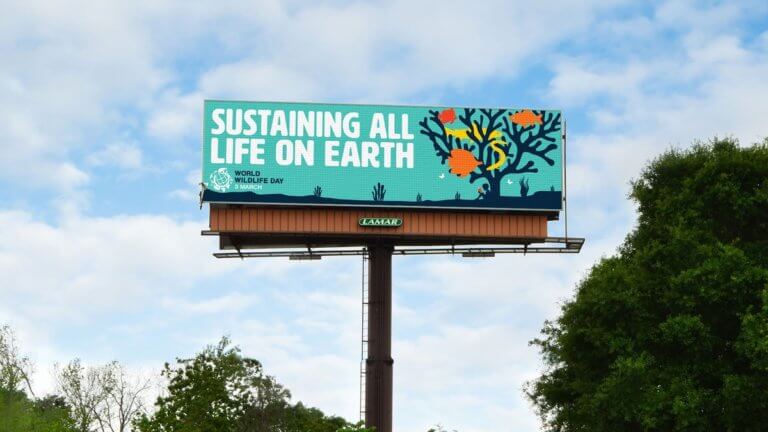
The world has come a long way from the industrial age to the digital age. Industries have provided many conveniences for our everyday life, however, somewhere along the way, the Earth has been taken for granted. The environment is in dire need for change and people have heard the call. The younger generations have become much more conscious of the consequences of climate change and are ready to do their part for mother nature and the future of our planet. But how can one make a significant impact on the masses? The answer could be to simply look upwards! OOH advertisements have an average capacity of 672 square feet of advertising space to voice their concerns about climate change and other social economic issues impacting our world today. Nowadays, brands have taken on the responsibility to address these issues to a large audience. In addition, advertising companies are now trying to be more proactive in minimizing their carbon footprint. Combining both efforts, OOH is an optimal way to demonstrate practical responses to climate change while voicing a call to action.
Out-of-home (OOH) advertising has emerged as a significant player in the environmental movement due to several key factors:
- Sustainable Practices: Many OOH advertising companies have adopted sustainable practices to reduce their environmental impact. This includes using eco-friendly materials for signage, implementing energy-efficient lighting technologies, and employing sustainable production and recycling processes.
- Green Initiatives: OOH companies increasingly invest in green initiatives such as carbon offset programs, tree planting campaigns, and partnerships with environmental organizations. These efforts showcase a commitment to environmental stewardship and sustainability.
- Digital Innovation: The shift towards digital OOH advertising has contributed positively to the environmental movement. Digital displays consume less energy than traditional static billboards, and they offer flexibility in content delivery without the need for physical materials like paper or vinyl.
- Message of Sustainability: OOH campaigns often include messages promoting environmental awareness, conservation, and responsible consumer behavior. By leveraging their wide reach and visibility, OOH advertisers can effectively communicate messages that encourage eco-friendly practices and support environmental causes.
- Public Engagement: OOH advertising can potentially engage the public in environmental issues through creative and impactful campaigns. From promoting recycling and waste reduction to raising awareness about climate change, OOH ads can inspire individuals to act towards a greener future.
- Advocacy and Partnerships: OOH companies collaborate with environmental advocates, government agencies, and businesses to promote sustainability goals. These partnerships facilitate the development of campaigns that align with environmental objectives and encourage positive behavior change.
- Regulatory Compliance: OOH advertisers are also mindful of regulatory requirements related to environmental standards. Adhering to regulations ensures that their operations and campaigns meet established criteria for sustainability and environmental responsibility.
Renewable Energy on the Rise
With the recent presidential election, the American people have addressed their concern regarding environmental issues by voting for the candidate that shares their values. President-elect Biden has given the American people a sense of hope that their country can now resume its efforts to slow climate change. With President-elect Biden pledging to rejoin the Paris Climate Agreement and the promise to fight global warming, renewable energy is becoming of greater importance. In recent years, many renewable energy companies and OOH advertising companies have already collaborated to create important messages for the public. Renewable energy companies are using billboards to advertise solar panels while showcasing their effectiveness in real time.
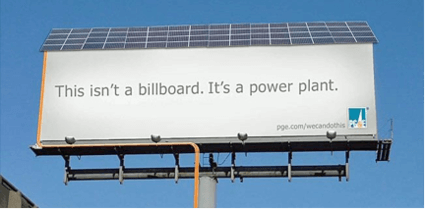
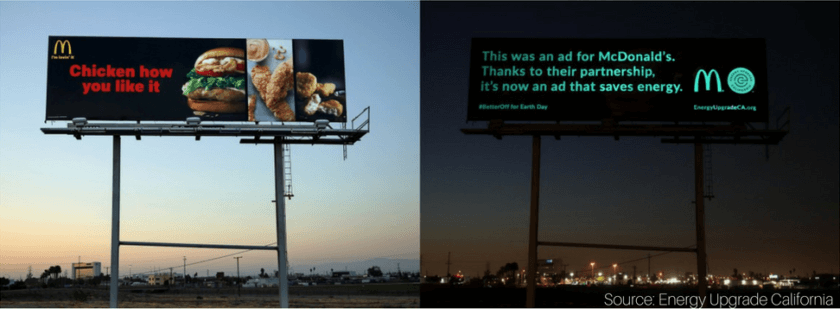
McDonalds partnered with Energy Upgrade California to create an energy efficient billboard on a Los Angeles highway. On Earth Day, the billboard’s lights were shut off, which transformed it into a glow-in-the-dark billboard that displayed an influential message about saving energy. The hashtag #BetterOff was used to generate buzz on social media.
By visually demonstrating the power of solar panels on billboards equipped with solar modules, these companies capture attention, raise awareness, and prompt individuals to learn about solar energy as a sustainable solution. The billboards act as educational platforms, emphasizing the benefits of solar power and encouraging viewers to consider the adoption of renewable energy for a greener future.
With President-elect Biden prioritizing environmental issues, we can conclude there will be a major growth in renewable energy, which in effect, will encourage more brands and advertising companies to hop on the bandwagon.
A Call for Action
The World Economic Forum asked all companies that attended its Annual Meeting to commit to achieving net zero carbon emissions by 2050 or sooner. Based on the 2020 Sustainable Business Leadership Survey, 82 percent of organizations stated that they will be more committed to achieving environmental goals in 2020. Nearly 78 percent of respondents to the survey “agreed” or “strongly agreed” that the climate strikes and “the Greta effect” had helped raise awareness about sustainability and energy issues within their organizations.
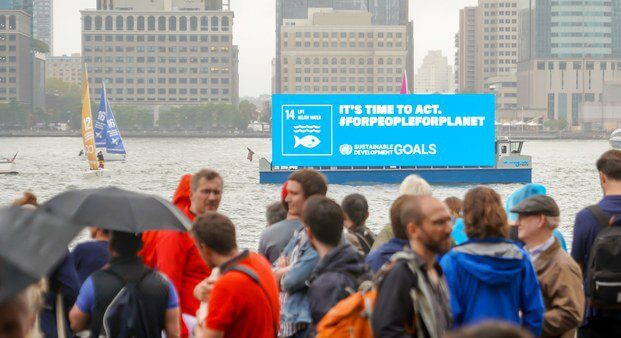
Greta Thunberg, the 17 year old Swedish activist, represents the younger generations who are concerned about their future and the future of their unborn children. Thunberg used a floating digital billboard to convey her message, “ It is time to act”, while arriving in New York to participate in the YOUTH Climate Summit and the Climate Action Summit at the UN Headquarters. Thunberg has been an inspiration to young activists to stand firm in their fight for climate change. Her impact on the world is driving more businesses to commit to climate action moving forward.
Brand’s Environmental Corporate Social Responsibility
A study by Nielsen reported that over 81% of participants felt strongly that companies should help improve the environment. They also declared supporting brands that show authentic commitment to environmental causes. Millennials, Generation Z, and X responded with the highest percentage when asked about the importance of corporate sustainability. This is an example of the strong influence consumers can have on brands. Brands must respond to their consumers ever-changing needs in order to maintain their status as a top-of-mind brand. This is where Corporate Social Responsibility comes into play. The environment is a global issue and brands now have to align their perceptions and values to those of Millennials and Generation Z, and X. Entering the year 2021, people have become well aware of the issues our planet is facing and are ready to be part of the solution. With that in mind, eco-friendly advertisements are now shifting from awareness campaigns to encouraging a change in consumer behavior, allowing consumers to witness and experience the effects of environmental issues first-hand.
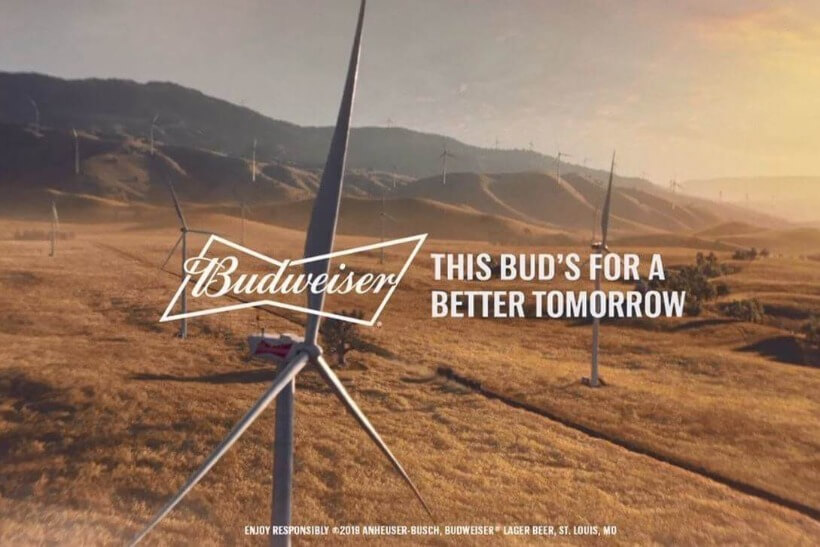
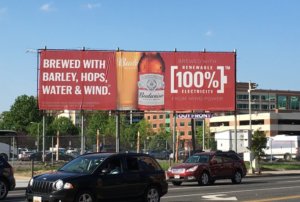
In 2019, Budweiser used an innovative ad campaign to tell America that they are brave and ready to seize the new world of renewable energy. Budweiser partnered with VaynerMedia and created a campaign involving custom radio ads that were controlled by the wind. The process began by tracking real-time data using the National Digital Forecast Database. The weather and direction of the wind determined where Bud’s message would be directed. The message stated that Budweiser is now brewed with 100 percent renewable electricity using turbines across the country. It was then adjusted and tailored to the town where the direction of the wind carried it. In total, the message covered 1,300 miles, 24 towns, and 5 states in over 96 hours. Using integrated marketing, OOH was used to complement the campaign with the emphasis on the purpose of it all – Budweiser beer now being brewed from 100% renewable energy from wind power.
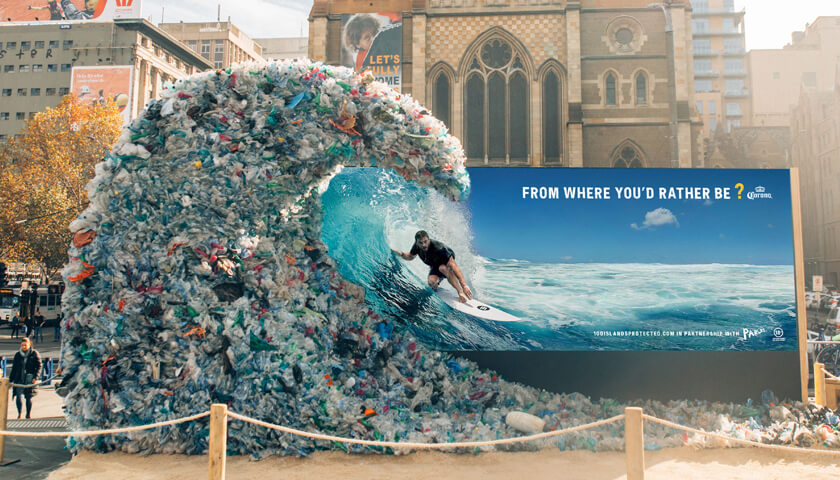
Corona teamed up with Parley for the Oceans to bring awareness to marine plastic pollution on World Oceans Day. The campaign used a bold and hard to miss OOH advertisement in Melbourne, London, Santiago, Bogota, Santa Domingo, and Lima. The protruding wave in front of the billboards were made entirely from 1,500kg of plastic trash, the equivalent amount that enters Australia’s oceans everyday. The billboard featured Australian Actor Chris Hemsworth surfing the wave with a tagline that read, “From where you’d rather be?” and, “This is Living?”. The trash was collected from the streets and nearby beaches in the weeks leading up to World’s Ocean Day. Corona’s mission was to purposely “trash” its own campaign to creatively highlight the fact that paradise-like beaches are becoming more and more scarce due to the excessive amounts of trash, and as a consequence, literally trashing the picture-perfect image of the beach.
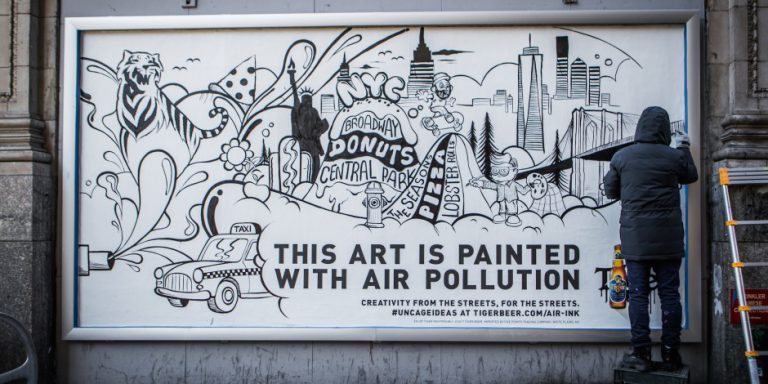
Heineken’s Tiger Beer Global Campaign, Air-Ink, won a Gold Lion at Cannes 2017 for its attention-grabbing take on art using air pollution as a substitute for ink. Artists were able to create an OOH street painting of New York City using only ink made from pollution. Air Ink Art was created and displayed in urban cities that have been dealing with more and more air pollution over the years, such as London, Berlin, Singapore, and New York. The campaign used a creative unconventional way to emphasize the shocking truth about the amount of CO2 in the atmosphere.
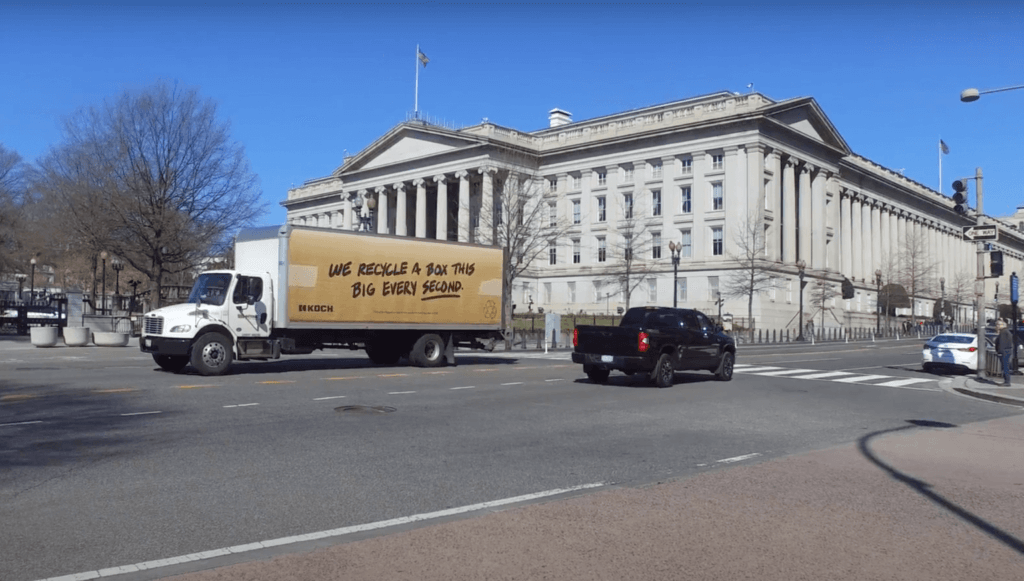
Movia, a mobile billboard advertising company, teamed up with Koch Industries to create a mobile OOH campaign in Washington, DC and Atlanta, Georgia. Koch Industries was clever in its approach by “transporting” a message about sustainability and ensuring that the campaign created net-zero emission pollution. This was made possible by Movia leveraging its partnership with third-party delivery trucks with a pre-established route. With a creative message stating, “We recycle a box this big every second”, the size and box-like shape of the truck compliments the message effortlessly. In addition to Koch Industries’ sustainability efforts, the campaign itself was part of a green initiative by Movia. As part of their tree planting carbon offsets, for every truck put on the road, a tree is planted. The partnership resulted in the planting 6,000 trees.
OOH For Environmental Organizations
We’ve established that brands are utilizing OOH advertisements in their eco-friendly campaigns to send a message to a broad number of consumers to show their support. However, brands are not the only ones benefiting from OOH in getting their message across. Various environmental organizations are also using OOH to encourage, educate, and influence the population to go green. OOH allows creative ideas and impactful taglines to come to life. Given the breadth of the space, it allows advertisers to think outside of the canvas itself. Advertisers have the opportunity to apply guerrilla marketing strategies using unconventional ways to generate buzz on important issues.
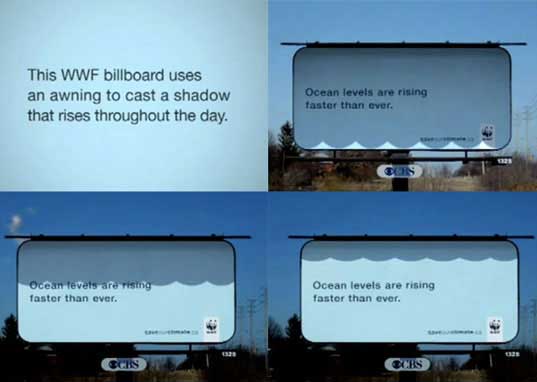
World Wildlife Fund used the Sun in an ingenious way to bring attention to the rising sea levels caused by global warming. As the Sun rises and sets, the movement of the shadows on the billboard demonstrates how the sea levels are rising. This billboard was developed years ago, yet still applies to our world today. In 2019, the global mean sea level was 3.4 inches above the 1993 average—the highest annual average on record from 1993 to the present day. From 2018 to 2019, the global sea level rose 0.24 inches. This advertisement is an ideal example of an impactful message that uses the shock factor to its advantage with an urgent call for change.
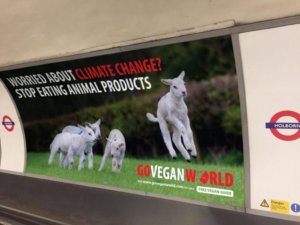
An Oxford University study concluded that the production of animal-based foods is a significant cause of greater greenhouse-gas emissions than the production of vegan foods. Go Vegan World expressed their concern for climate change with a targeted message to non-vegetarians urging them to convert to veganism if they are worried about climate change. Go Vegan World used an emotional and persuasive advertising message encouraging consumers to stop eating animal products. The intent of the ad was to make consumers realize that their diet choices can directly impact the environment, and that by converting to Veganism they could be part of the change our planet needs in its struggle with climate change.


World Population Balance recently launched OOH billboards in Vancouver to create awareness about overpopulation and the consequences it has on the environment. The One Planet, One Child website placed on the advertisement provides real-time statistical data on world population growth. Executive Director Dave Gardner stated, “We want to get Canada talking about overpopulation”, claiming that many are unaware or uncomfortable talking about this issue. The World Population Balance campaign used a positive tone that encouraged couples to make more informed decisions about the family size they are considering, as well as thanking those who have opted for the small-family decision.
The Bottom Line
The 21st Century has seen a significant increase in environmental awareness and activism that has led to a go-green trend for brands, organizations, advertising companies, and most importantly, the consumers themselves. Moving forward, the environmental movement will transform from a trend to a duty humans must take part in to sustain a healthy planet for the future. The environmental movement is predicted to grow in the coming years. Leading factors like President-elect Biden, who prioritizes climate change and emerging activists, such as Greta Thunberg, will strongly influence consumers and businesses to act. As consumers request that companies commit to their Corporate Social Responsibility and Environmental Social Governance efforts, more businesses are adopting pro-green initiatives and voicing it to the public. OOH advertisements are providing brands with an appropriate medium to match sustainable messaging, as brands aspire to uphold consumers’ wants and needs. With solar panel billboards on the rise and creative OOH ad space, brands and organizations are better equipped to lead a successful green campaign.
Overall, OOH advertising’s role in the environmental movement underscores the industry’s evolving commitment to fostering positive environmental change and promoting a more sustainable society. By integrating green practices, advocating for environmental causes, and engaging the public, OOH has become a key player in driving awareness and action towards a greener and cleaner future.


